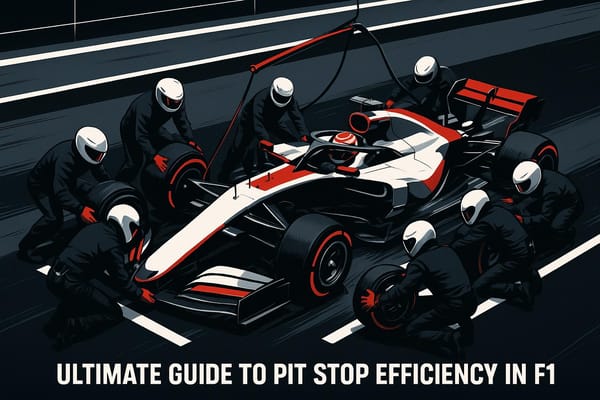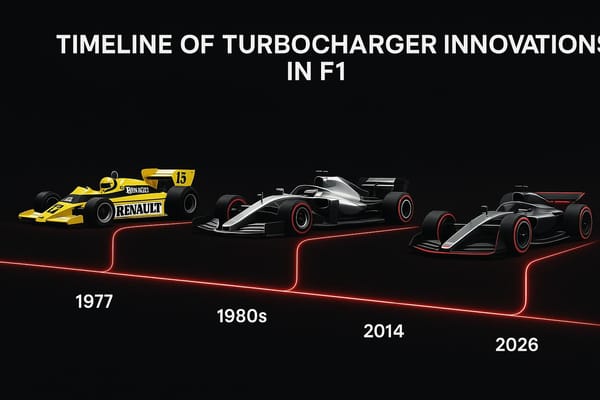Measuring Competitive Balance in F1 Over Decades
Explore the changing dynamics of competitive balance in Formula One, examining how eras of dominance and regulation shifts shape the sport.

Formula One's competitive balance refers to how evenly success is shared among teams and drivers over time. This balance impacts fan engagement, revenue, and the sport's overall appeal. Historical data from 1950 to 2018 shows that while the drivers' championship has been relatively balanced (Gini coefficient: 0.350), the constructors' championship has been more concentrated (Gini coefficient: 0.503).
Key takeaways:
- Dominant eras, like Schumacher's Ferrari (2000–2004) and Mercedes' hybrid era (2014–2021), highlight how technical and strategic advantages can skew competition.
- Regulatory changes, such as the 2014 hybrid engines and the 2021 cost cap, have had mixed effects on leveling the playing field.
- Metrics like the Gini coefficient, Herfindahl-Hirschman Index, and standard deviation of points help measure and compare balance across eras.
F1's competitive balance cycles between dominance and parity, influenced by rule changes, technological shifts, and team resources. For the sport to remain engaging, balancing innovation with fairness is critical.
F1’s flawed financial model explained
Methods for Measuring Competitive Balance
Building on the historical context, we can now explore how Formula One's competitive balance has shifted over time due to regulatory and technological changes. To quantify this, three key metrics are commonly used: the Gini coefficient, the Herfindahl-Hirschman Index (HHI), and the standard deviation of points.
Key Metrics for Competitive Balance
The Gini coefficient is a tool borrowed from economics to measure inequality - in this case, the distribution of points among drivers or teams. Its values range from 0 (perfect equality) to 1 (maximum inequality). Between 1950 and 2018, Formula One's drivers' championship recorded a Gini coefficient of 0.350, reflecting a relatively balanced competition compared to many other sports. This metric offers a standardized way to compare competitiveness across different eras.
The Herfindahl-Hirschman Index (HHI) evaluates how concentrated success is by summing the squares of each competitor's share of total points or wins. Higher values indicate more concentrated success. For example, this metric highlights Ferrari's dominance in the early 2000s under Michael Schumacher, where a single team amassed much of the success.
The standard deviation of points measures how spread out the points are among competitors. A higher standard deviation indicates less balance, as it reflects a larger gap between top performers and the rest of the field. While straightforward to calculate, this metric can be tricky to interpret when comparing seasons with different numbers of races or competitors.
A newer metric, the Kendall corrected evolutive coefficient, has been used to track ranking changes over time. Studies from 2012 to 2022 have applied this measure to compare Formula One's competitive balance with that of major football leagues, offering a dynamic view of how competition evolves throughout a season rather than relying solely on final standings.
These metrics provide a foundation for analyzing competitive dynamics. Next, we look at how race-level and season-level analyses offer complementary perspectives.
Race-Level vs. Season-Level Analysis
The scope of the analysis - whether focusing on individual races or entire seasons - shapes the insights these metrics can provide.
Race-level analysis zooms in on individual Grand Prix events, examining factors like margin of victory, lead changes, or position shifts from start to finish. This approach captures the immediate drama of a race. Even during seasons where one team dominates, individual races can still deliver close battles and unexpected outcomes.
On the other hand, season-level analysis takes a broader view, looking at how points, wins, and championships are distributed across all races in a year. This perspective reveals patterns of sustained dominance or tight title battles that unfold over time. It’s particularly useful for assessing the effects of regulatory changes - like adjustments to technical rules or scoring systems - on competitive balance. While race-level analysis highlights short-term fluctuations, season-level analysis paints a clearer picture of long-term trends.
Together, these perspectives provide a fuller understanding of Formula One's competitive landscape.
Strengths and Weaknesses of Metrics
Each metric offers unique insights but also comes with limitations:
| Metric | Strengths | Weaknesses |
|---|---|---|
| Gini Coefficient | Measures overall inequality; allows for cross-sport comparisons; widely used in academic research | Can be skewed by zero-point finishers; doesn’t capture race-by-race dynamics |
| Herfindahl-Hirschman Index | Easy to interpret; highlights concentrated success; well-established in economic studies | Overemphasizes dominant performances; less sensitive to mid-field competition |
| Standard Deviation | Simple to calculate; provides an intuitive view of performance gaps | Doesn’t adjust for the number of competitors; hard to compare across eras with different scoring systems |
Applying these metrics effectively requires careful consideration of Formula One's evolving format. Challenges include handling mid-season rule changes, driver transfers, and differing numbers of competitors over the years. For example, the standard deviation is particularly sensitive to changes in race calendars, scoring systems, and team participation. Standardizing data across eras is essential for meaningful comparisons.
Ultimately, the most insightful analyses combine multiple metrics, acknowledging their strengths and weaknesses, to capture the complex story of competitive balance in Formula One.
Trends in Competitive Balance Across F1 Eras
Formula One's competitive dynamics have evolved significantly over its seven-decade history, marked by cycles of dominance and parity. These shifts have been influenced by technical advancements, rule changes, and extraordinary individual performances. Let’s dive into the patterns and factors that have shaped the sport’s competitive landscape.
Dominant Eras in F1
Formula One has seen three major periods of dominance that reshaped the competitive balance of the sport. These eras highlight how a mix of technical innovation, strategic investments, and remarkable talent can lead to prolonged supremacy.
Juan Manuel Fangio's dominance (1951–1957) set the standard for individual brilliance in F1. During this time, Fangio secured five World Driver Championships, contributing to a WDC Gini coefficient of 0.360 for the 1950s. His success was a testament to unmatched driving skill and his knack for aligning with the right teams at the right moments, creating a clear imbalance in the sport for nearly a decade.
The Michael Schumacher-Ferrari era (2000–2004) stands out as one of the most dominant periods in modern F1. Schumacher’s five consecutive titles helped Ferrari end a 21-year championship drought in 2000. By 2002, their dominance was so overwhelming that the FIA introduced regulation changes to level the playing field. The 2000s recorded a WDC Gini coefficient of 0.360, tying with the 1950s as one of the least competitive decades in F1 history.
More recently, the Mercedes hybrid era (2014 onward) has showcased dominance driven by technical expertise. Their early investment in hybrid power units and superior aerodynamic developments gave them a significant edge in both driver and constructor championships. This period contributed to a WCC Gini coefficient of 0.056 during 2010–2018, highlighting extreme concentration of success among constructors.
These eras underline a recurring theme: exceptional talent paired with cutting-edge technology can dramatically skew competitive balance, as reflected in higher Gini coefficients during such periods.
Impact of Scoring and Format Changes
Changes in Formula One's scoring systems and race formats have also played a significant role in shaping competitive balance, though their effects have been mixed.
The 2010 expansion of points to the top 10 finishers aimed to give midfield teams more opportunities to score. While this helped reduce the WDC Gini coefficient to 0.222 (from the previous decade’s 0.360), the WCC Gini coefficient worsened significantly to 0.056, indicating a growing gap in constructor success.
The introduction of sprint races has added an unpredictable element to race outcomes, potentially redistributing points among teams. However, the long-term impact of this format on competitive balance is yet to be fully understood.
Historically, changes in scoring systems have coincided with some of F1’s most competitive periods. However, it’s challenging to isolate the impact of these changes from broader technological and regulatory shifts occurring at the same time.
Visualizing Competitive Balance Over Time
Examining competitive balance metrics over the decades provides a clear picture of Formula One’s evolution. The table below highlights these trends:
| Decade | WDC Gini Coefficient | WCC Gini Coefficient | Balance Level |
|---|---|---|---|
| 1950s | 0.360 | N/A | Low (most imbalanced) |
| 1960s | 0.171 | 0.233 | High (most balanced) |
| 1970s | 0.171 | 0.300 | High (most balanced) |
| 1980s | 0.267 | 0.133 | Moderate-High |
| 1990s | 0.171 | 0.350 | High (WDC) / Moderate (WCC) |
| 2000s | 0.360 | 0.400 | Low (most imbalanced) |
| 2010–2018 | 0.222 | 0.056 | Moderate (WDC) / Very Low (WCC) |
The 1960s, 1970s, and 1990s stand out as the most balanced periods, with WDC Gini coefficients of 0.171. These decades saw multiple teams and drivers sharing success more evenly, reflecting a healthier level of competition.
Interestingly, the data shows a steady improvement in competitive balance from the 1950s through the early 1990s, as indicated by declining Gini coefficients. However, this trend reversed in the 2000s, with dominance reasserting itself in both driver and constructor championships.
A notable pattern emerges when comparing the World Drivers' Championship (WDC) and World Constructors' Championship (WCC). The WDC consistently shows better balance than the WCC, likely due to the shorter careers of drivers compared to the longer operational periods of teams.
Recent history also offers hope for renewed balance. The 2005–2006 seasons, when Renault and Fernando Alonso ended Ferrari’s dominance, demonstrated that competitive balance can return after extended periods of inequality. Yet, the dominance of Mercedes during the hybrid era serves as a reminder that Formula One is prone to cycles of parity and dominance.
Interestingly, when compared to other major sports, Formula One holds its own in terms of competitive balance. The sport’s WDC Gini coefficient of 0.350 (1950–2018) is better than that of the NBA (0.538) and NHL (0.526) and is comparable to the NFL (0.409). This suggests that despite its high-profile dominant periods, Formula One maintains a reasonable level of competition over time.
Regulation Changes and Competitive Balance
Formula One's governing body often uses regulation changes to influence the competitive dynamics of the sport. These changes have had varied outcomes - some have shaken up the established order, while others have unintentionally reinforced existing dominance. Examining these patterns sheds light on how rule changes interact with team budgets, technical expertise, and overall readiness. Let’s dive into some key regulation overhauls and their effects on competitive balance.
Impact of Major Regulation Overhauls
Throughout F1 history, certain regulation changes have reshaped the competitive landscape - some more successfully than others. Take the 2014 introduction of hybrid power units, for instance. This was one of the sport’s most dramatic technical shifts, but instead of leveling the playing field, it gave Mercedes a massive edge. Their superior preparation led to an era of dominance, with the team clinching eight consecutive constructors' championships from 2014 to 2021.
On the other hand, the 2021 cost cap introduced a different kind of reform, focusing on financial equality. By limiting teams to approximately $145 million in performance-related spending, the aim was to reduce the gap between powerhouse manufacturers and smaller teams. While early signs show some narrowing of performance gaps, Red Bull’s dominance in the 2022–2023 seasons suggests that the full impact of this measure may take several years to unfold as teams adjust to the new financial constraints.
Interestingly, history shows that regulation changes often create temporary chaos, but dominant teams tend to adapt quickly. Even when the initial disruption is dramatic, established hierarchies frequently reassert themselves over time.
Stability vs. Instability in Regulations
The relationship between stable regulations and competitive balance is a tricky one. When rules remain consistent over long periods, dominant teams often strengthen their advantage. However, frequent changes can shake things up - though they also come with their own set of challenges.
For example, the Mercedes era (2014–2020) coincided with a period of stable hybrid engine regulations. This allowed Mercedes to refine their car year after year, cementing their dominance. Similarly, Red Bull’s recent success (2022–2023) has occurred during a relatively stable regulatory environment following major aerodynamic changes introduced in 2022. Studies using tools like the Gini coefficient and the Herfindahl-Hirschman Index (HHI) reveal that periods of regulatory stability often align with prolonged dominance by one team.
Conversely, major regulation overhauls can temporarily level the playing field by forcing all teams to start from scratch. However, the effectiveness of these changes depends on their scope and enforcement. Stronger teams, with better resources and adaptability, tend to regain their edge quickly, even after initial disruptions. Striking the right balance between regulatory stability and change is an ongoing challenge for F1's policymakers.
Examples of Regulation-Driven Parity
History offers several examples where well-designed regulation changes temporarily increased competitive balance.
One standout case is the 1981 ban on ground effect aerodynamics, which forced teams to completely rethink their car designs. This reset the technical advantage of leading teams and resulted in a more competitive field in the following seasons.
Another example is the 1966 engine regulation overhaul, which introduced new engine size limits and technical specifications. This opened the door for a wider variety of teams and manufacturers to compete. Between 1966 and 1980, 12 new Grand Prix winners emerged, showcasing a more diverse competitive environment compared to earlier years.
However, not all regulation changes have been successful. During the 1989–1993 period, no new Grand Prix winners emerged, highlighting how minor or poorly executed changes can fail to disrupt the status quo. This underscores the importance of comprehensive reforms that truly reset competitive advantages.
The 2002 season is another telling example. Ferrari and Michael Schumacher dominated that year, with Schumacher winning 11 of 17 races. In response, the FIA introduced measures like one-shot qualifying and a revised points system. These changes disrupted Ferrari's dominance, paving the way for Renault and Fernando Alonso to win championships in 2005 and 2006.
| Regulation Change | Period | Competitive Impact | Key Outcome |
|---|---|---|---|
| Engine size change | 1966–1980 | Increased parity | 12 new Grand Prix winners |
| Ground effect ban | 1981 | Significant balance shift | Multiple teams became competitive |
| Post-Ferrari dominance | 2003–2005 | Disrupted dominance | Renault broke Ferrari's streak |
| Hybrid power units | 2014–present | Initial imbalance | Mercedes' 8-year dominance |
These examples show that achieving greater parity through regulations requires sweeping changes that alter competitive dynamics rather than incremental tweaks. The most effective interventions combine technical, financial, and sporting reforms to create meaningful opportunities for underdog teams to challenge the usual frontrunners.
Conclusion: Lessons from F1's Competitive Balance Evolution
Key Takeaways on Competitive Balance
Formula One's journey highlights a clear trend: without deliberate intervention, competitive balance tends to diminish over time. Historical data shows that success has become increasingly concentrated among a smaller number of teams and drivers, particularly from the sport’s early days through the early 1990s.
Interestingly, while driver championships have remained relatively balanced, the dominance of certain constructors has been far more pronounced. In fact, F1's driver championship displays more balance compared to other major sports leagues, such as the Premier League (0.489), La Liga (0.591), and the NBA (0.538).
Regulatory shifts have played a pivotal role in reshaping competitive dynamics. Some rule changes have leveled the playing field temporarily, while others have inadvertently strengthened the dominance of well-prepared teams. For instance, the introduction of the $145 million cost cap in 2021 was designed to reduce resource disparities. Early results from three seasons suggest this measure is starting to close performance gaps. Similarly, changes like expanding points-paying positions in 2010 have softened the impact of dominant performances, though underlying disparities in team performance still persist.
These lessons offer a foundation for understanding how F1 might tackle future challenges tied to competitive balance.
Future Outlook for Competitive Balance in F1
Formula One's competitive landscape is on the brink of significant shifts, driven by both opportunities and challenges. The upcoming 2026 regulations are expected to bring major changes, particularly with advancements in brake technology and a greater emphasis on electric power integration. These developments will introduce fresh engineering hurdles that could shake up the current team hierarchy.
Financial regulations, such as the cost cap, have shown early signs of success but will need continuous refinement. While the cap has helped reduce performance disparities, its long-term impact will depend on the FIA’s ability to address loopholes and adapt spending limits as the sport evolves. A combination of technical, financial, and sporting regulations appears to be the most effective strategy, as no single measure can fully counteract dominance.
Advanced metrics like the Gini coefficient and the Herfindahl-Hirschman Index will be key tools for implementing precise, data-driven solutions in the years ahead. However, challenges persist: rapid technological advancements often benefit early adopters, and the resource gap between large manufacturers and smaller teams remains a significant obstacle.
The governing bodies of F1 face a challenging task: maintaining the sport’s status as the pinnacle of motorsport innovation while ensuring it remains thrilling and competitive for fans. History suggests the best path forward lies in a proactive approach - one that combines robust regulation, financial oversight, and transparent governance to strike a balance between fostering innovation and promoting fairness on the track.
FAQs
How are the Gini coefficient and Herfindahl-Hirschman Index used to measure competitive balance in Formula One?
The Gini coefficient and the Herfindahl-Hirschman Index (HHI) are two key metrics often used to evaluate competitive balance in Formula One. They focus on how success - whether in points or wins - is distributed among teams and drivers over time.
- The Gini coefficient measures inequality. A score closer to 0 suggests a more even distribution of success, meaning competition is well-balanced. On the other hand, a score closer to 1 points to dominance by just a few teams or drivers.
- The HHI looks at concentration by summing the squares of each team’s or driver’s share of points or wins. Lower scores indicate a more competitive field, while higher scores signal a concentration of success in the hands of a few.
These tools give fans and analysts a way to track shifts in Formula One’s competitive dynamics, identifying eras marked by fierce competition or dominance by specific teams or drivers.
How have major regulation changes, like hybrid engines and the cost cap, influenced F1's competitive balance?
Major changes in regulations, like the introduction of hybrid engines and the cost cap, have significantly influenced the competitive dynamics in Formula One over time. When hybrid engines were introduced in 2014, they marked a major technological leap. However, this shift initially favored teams with extensive research and development resources, creating a larger gap between the top teams and those in the middle of the pack.
The cost cap, a more recent change, was designed to address this disparity by setting limits on team budgets. The goal is to create a fairer playing field. Though it’s still too soon to fully measure its impact, the cost cap has already helped smaller teams compete more effectively. This could lead to closer races and a championship that’s harder to predict.
Why do some eras in F1 have closer competition while others are dominated by specific teams?
The intensity of competition in Formula 1 shifts from era to era, influenced by a mix of factors. One of the biggest influences is regulation changes. New rules can shake things up by either creating a more level playing field or favoring teams that adapt faster than others.
Then there’s the role of technology. Teams that push the boundaries with advanced innovations often gain a noticeable edge, leaving their rivals scrambling to catch up.
Money, of course, is another game-changer. Teams with deeper pockets can pour more into research, development, and assembling a dream team of engineers and drivers. These factors together create cycles where one team might dominate for years, only for the balance to shift and usher in a new competitive era.




